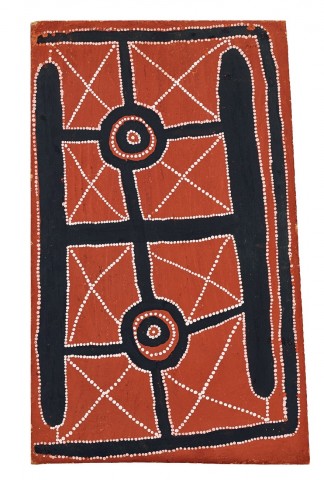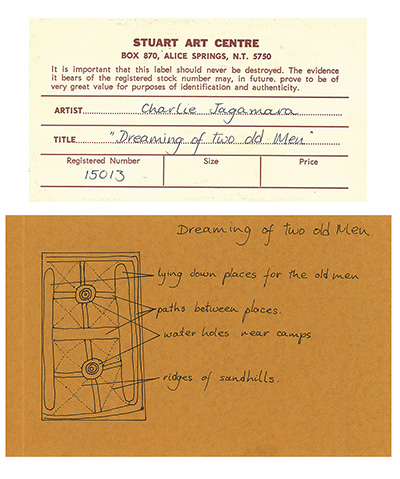STORY OF TWO OLD MEN, 1972
CHARLIE WARD TJAKAMARRA
synthetic polymer powder paint and PVA on composition board
46.0 x 29.0 cm (irregular)
Painted at Papunya, Northern Territory in 1972
Stuart Art Centre, Alice Springs (painting 13, consignment 15)
Private collection, USA, acquired from the above in November 1972
Private collection, USA
This work is accompanied by documentation from the Stuart Art Centre, Alice Springs.
In his recollections of the early years of the Western Desert painting movement at Papunya, Geoffrey Bardon referred to Charlie Tjakamarra as an occasional painter who ‘would sometimes visit the Great Painting Room … and sit with Anatjari No. III Tjakamarra and sometimes with George Tjangala’.1 However Charlie Tjakamarra soon moved away from Papunya to live at Warakurna, Docker River and Warburton before settling in the Pintupi community of Kiwirrkurra in the mid-1980s. From then-on he painted consistently for Papunya Tula Artists under the name of Charlie Ward Tjakamarra. He became a leading exponent of the minimal linear style of painting favoured by Pintupi artists such as the brothers Willy Tjungurrayi (born c.1932) and George Ward Tjungurrayi (born c.1945).
Among Tjakarmarra’s major achievements was a leading role in the great collaborative Kiwirrkurra Men’s Painting Untitled, 1999 that featured in the landmark exhibition of Papunya painting, Genesis and Genius at the Art Gallery of New South Wales, Sydney in 2000.2 At Kiwirrkurra, Charlie Tjakamarra also collaborated on paintings with his third wife, Yukultji Napangardi who is now at the vanguard of contemporary Pintupi painters.
Story of Two Old Men, 1972 is one of three known paintings by the artist from the early 1970s. It was recorded as Painting number 13 in Consignment 15 from Papunya to the Stuart Art Centre, Alice Springs, the main outlet for Papunya paintings at that time. Two other paintings by Tjakamarra were recorded in the previous consignment to the Stuart gallery. One is a double-sided board from 1971, Tingari men sitting around waterholes, in the collection of the Museum and Art Gallery of the Northern Territory, Darwin3 that features an image related to this lot. The second painting, Two Snake Dreaming painted in March – April 1972,4 features bold black forms outlined in dots against an ochre red ground similar to those found in Story of Two Old Men.
According to Bardon’s documentation accompanying the painting, the two black verticals represent places where two Old Tingari Men rested, the horizontals are the pathways connecting these places, and the roundels symbolize the waterholes near the men’s camps. The crossed lines of white dots represent ridges of desert sandhills.
1. Bardon, G. and J. Bardon, Papunya, A Place Made After the Story: The Beginnings of the Western Desert Painting Movement, The Miegunyah Press, Melbourne, 2004, p. 71
2. Held in the Kerry Stokes Collection, Perth and illustrated in Perkins, H. and H. Fink (eds), Papunya Tula: Genesis and Genius, Art Gallery of New South Wales in association with Papunya Tula Artists, Sydney, 2000, p. 161
3. Scholes, L. (ed.), Tjungunutja: From having come together, Museum and Art Gallery of the Northern Territory, Darwin, 2017, p. 48 (illus.)
4. Bardon, G. and J. Bardon, p. 342, painting 288 (illus.)
WALLY CARUANA

